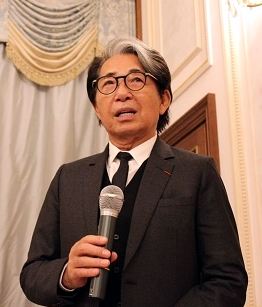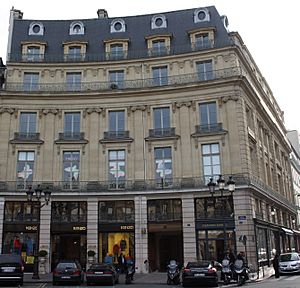Kenzō Takada facts for kids
Quick facts for kids
Kenzō Takada
|
|
|---|---|
| 高田 賢三 | |

Takada in 2017
|
|
| Born | 27 February 1939 |
| Died | 4 October 2020 (aged 81) Neuilly-sur-Seine, Île-de-France, France
|
| Alma mater | Bunka Fashion College |
| Occupation | Fashion designer, film director |
| Known for | Founder of Kenzo |
| Partner(s) | Xavier de Castella |
| Awards | Ordre des Arts et des Lettres |
Kenzō Takada (高田 賢三, born February 27, 1939 – died October 4, 2020) was a famous Japanese fashion designer. He lived in France for most of his life. Kenzō Takada created the well-known clothing brand called Kenzo. This brand sells clothes, skin care products, and perfumes all over the world. He was also the honorary president of the Asian Couture Federation.
Contents
Early Life and Education
Kenzō Takada was born in Himeji, Japan, on February 27, 1939. He was one of seven children. His parents, Kenji and Shizu Takada, ran a hotel. Kenzō loved fashion from a young age, especially by reading his sisters' fashion magazines.
In 1957, he briefly went to Kobe City University. But his father passed away during his first year. Kenzō then left the university, even though his family didn't want him to. In 1958, he joined Tokyo's Bunka Fashion College. This college had just started accepting male students. While there, Kenzō won a fashion design contest called the Soen Award in 1961. He also gained experience working at a department store called Sanai. He designed many outfits for girls there.
Kenzō was very inspired by Paris, especially by the designer Yves Saint Laurent. His teacher at Bunka, Chie Koike, also encouraged his interest in Paris. She had studied at a famous fashion school in Paris.
In 1964, Kenzō's apartment was torn down to make way for the 1964 Summer Olympics. He received some money for this. His mentor advised him to use this money to travel. So, Kenzō took a month-long boat trip to Paris. He stopped in cities like Hong Kong, Saigon, Mumbai, and Marseille. He finally arrived in Paris on January 1, 1965. At first, Paris seemed "dismal and bleak" to him. But he started to like the city when his taxi passed the beautiful Notre-Dame de Paris.
Starting a Fashion Career
When Kenzō first arrived in Paris, things were tough. He sold sketches of his designs to fashion houses for a small amount of money. He planned to return to Japan after a few months. But he decided to stay until he had created something special in Paris. He wanted to open his own fashion shop in a unique area. During this time, Kenzō worked as a stylist for a fabric company called Pisanti.
In 1970, Kenzō found a small space to rent cheaply in the Galerie Vivienne. He decided to open his own design shop there. He didn't have much money. So, he bought about $200 worth of fabrics from a market in Montmartre. He mixed these fabrics to create a colorful and bold first collection. Kenzō showed this collection at his first fashion show in the Galerie Vivienne. He couldn't afford professional models. So, he and his friends used their creativity to make the show happen.
Kenzō was inspired by the painter Henri Rousseau and his painting The Dream. He painted the inside of his shop to look like a jungle with lots of flowers. He wanted to combine this jungle look with his Japanese background. So, he named his first store "Jungle Jap." The name later caused some discussion. In 1971, he was asked to change the name. Kenzō and his team decided to rename the brand once he returned to France.
Growing the Kenzo Brand
Kenzō's hard work quickly paid off. In June 1970, the magazine Elle featured one of his designs on its cover. He moved his shop to the Passage Choiseul in 1970. In 1971, Kenzō's collection was shown in New York City and Tokyo. The next year, he won a prize from the Fashion Editor Club of Japan.
In the mid-1970s, Kenzō made a big impact on fashion. He changed the popular styles by making clothes looser and more voluminous. This new style was called the "Big Look." It soon became a major fashion trend. In October 1976, Kenzō opened his main store, Kenzo, in the Place des Victoires.
Kenzō was known for his exciting fashion shows. In 1978 and 1979, he held his shows in a circus tent! They ended with performers on horseback wearing see-through outfits, and Kenzō himself riding an elephant. He even directed a film called Yume, yume no ato, which came out in 1981.
Kenzō's business grew a lot in the 1980s. Kenzo's yearly sales increased from about 30 million French francs in 1979 to 240 million in 1984. Kenzō launched his first collection for men in 1983. In 1984, The Limited Stores signed Kenzō to design a more affordable clothing line called Album by Kenzo. A children's clothing line, Kenzo Jungle, and men's and women's jeans were released in 1986.
Kenzō also started creating perfumes. He first experimented with perfumes by releasing King Kong in 1980, just "for fun." In 1988, his women's perfume line began with Kenzo de Kenzo (now called Ça Sent Beau), Parfum d'été, Le monde est beau, and L'eau par Kenzo. Kenzo pour Homme was his first men's perfume in 1991. FlowerbyKenzo, launched in 2000, is considered one of the best classic French perfumes ever. In 2001, a skincare line called KenzoKI was also launched.
Since 1993, the Kenzo brand has been owned by the French luxury company LVMH. In 2016, Kenzō created a perfume for Avon.
Later Career and Retirement
Kenzō Takada announced his retirement from fashion in 1999. He wanted to focus on art. Roy Krejberg and Gilles Rosier took over designing Kenzo's clothing lines.
However, in 2005, Kenzō returned as a decoration designer. He launched Gokan Kobo, a brand for tableware, home items, and furniture. He said that after resting and traveling, he wanted to work in decoration rather than fashion. In 2013, Kenzo became the first Honorary President of the Asian Couture Federation. In 2010, his paintings were shown in a special exhibition in Paris called "Un Certain Style de Vie" (A Certain Way of Life).
Kenzō Takada received important honors. He was made a Knight of the Legion of Honour in France on June 2, 2016. He also received a Lifetime Achievement Award at the 55th Fashion Editors' Club of Japan Awards in 2017. That same year, Kenzō worked with Roche Bobois to create new designs for their Mah Jong sofa and a line of ceramics.
Even after leaving the fashion industry, Kenzō sometimes returned to it. In 2019, he designed costumes for a production of Madama Butterfly by the Tokyo Nikikai Opera Foundation. He also used his design skills in other ways. He collaborated with the Mandarin Oriental Jumeira in Dubai to design the hotel's first publicly displayed Christmas tree during the 2019 holiday season.
In January 2020, Kenzō announced a new lifestyle brand called K3. The brand first appeared on January 17, 2020, at a trade show in Paris.
Personal Life and Passing
Kenzō Takada was in a relationship with French architect Xavier de Castella. Xavier sadly passed away in 1990. Xavier helped design Kenzō's large Japanese-style house, which was built between 1987 and 1993.
Kenzō Takada passed away on October 4, 2020. He was 81 years old. He died from complications related to COVID-19 while in the hospital in Neuilly-sur-Seine, France.
Awards and Recognition
- France: Ordre des Arts et des Lettres / Chevalier, 1984
- Japan: Medals of Honor / Medal with Purple Ribbon, 1999
- France: Legion of Honour / Chevalier, 2016
Images for kids





 In Spanish:
In Spanish: